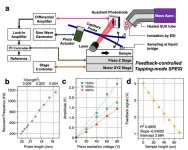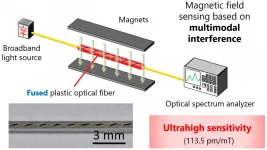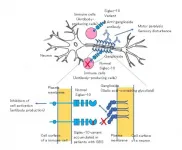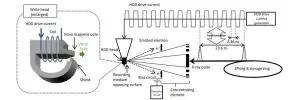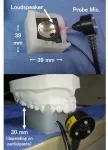(Press-News.org) With an estimated lifespan between 25 to 40 years, the queen conch (Strombus gigas) is a prized delicacy long harvested for food and is revered for its beautiful shell. Second only to the spiny lobster, it is one of the most important benthic fisheries in the Caribbean region. Unfortunately, the species faces a challenge of survival: how to endure and thrive, as populations are in a steady state of decline from overfishing, habitat degradation and hurricane damage. In some places, the conch populations have dwindled so low that the remaining conch cannot find breeding partners. This dire situation is urgent in ecological and economic terms.
To preserve this most significant molluscan fishery in the Caribbean, a scientist from Florida Atlantic University's Harbor Branch Oceanographic Institute has dedicated more than four decades of research into the science and art of growing queen conch. Her latest contribution - an 80-page, step-by-step user manual that provides complete illustrations and photos of how to culture queen conch. The "Queen Conch Aquaculture: Hatchery and Nursery Phases User Manual," was recently published in the National Shellfisheries Association's Journal of Shellfish Research.
The manual is a deliverable of the Puerto Rico Saltonstall-Kennedy National Oceanic and Atmospheric Administration (NOAA) Fisheries grant, which is a two-year collaboration and project with Conservación Conciencia, the Naguabo Commercial Fishing Association and fishers in Puerto Rico.
"I wrote this edition for the Puerto Rican fishers of the Naguabo Fishing Association who are learning to operate the Naguabo Queen Conch Hatchery and Nursery," said Megan Davis, Ph.D., author and a research professor of aquaculture and stock enhancement, FAU's Harbor Branch, who collaborated with Victoria Cassar, a science communicator who designed the manual. "However, the majority of the information presented in this new manual can be applied to other queen conch hatchery and nursery projects to produce conch for sustainable seafood, conservation and restoration."
Last year, Davis teamed up with Conservación ConCiencia in Puerto Rico to assist with stock enhancement fisheries of the queen conch. The goal: to produce up to 2,000 queen conch juveniles in a fishers-operated aquaculture facility for release into conch juvenile habitats. The Saltonstall-Kennedy NOAA-funded project includes aiding sustainable fisheries practices through aquaculture. The team is working with the fishery communities, utilizing the commercial Fishing Association's working waterfront for conch aquaculture infrastructure, helping provide diversified incomes for the fishery communities, promoting aquaculture practices, and ensuring the conch population is available for future fishing and food security through aquaculture and restoration.
"Aquaculture, along with conservation of breeding populations and fishery management, are ways to help ensure longevity of the species," said Davis. "Our queen conch aquaculture project in Puerto Rico will serve as a model to ensure that conch populations are available for future fishing and to aid food security for Puerto Rico and elsewhere in the Caribbean region."
With requests for queen conch mariculture know-how coming from many communities throughout the Caribbean including The Bahamas, Puerto Rico, Curacao, Antigua, and Turks and Caicos Islands, and with the recent release of this manual, Davis and partners are expanding their Caribbean-wide queen conch conservation, education and restorative mariculture program.
Desired outcomes include establishing protected areas where conch breeding populations can spawn egg masses for future populations; raising queen conch for education, conservation, restoration and sustainable seafood through the establishment of in-classroom, research, pilot-scale or commercial size hatcheries; and locating protected habitats to release hatchery-reared juvenile conch to help repopulate seagrass beds to rebuild conch stocks.
"Forty years of queen conch mariculture research and pilot-scale to commercial application conducted by Dr. Davis holds promise as a way of addressing this critical situation with the queen conch through community-based solutions," said James Sullivan, Ph.D., executive director of FAU's Harbor Branch. "There are no other mariculture labs with the knowledge and capacity that she brings to the table to tackle the plight of the queen conch."
This new, in-depth manual will be used to support the eLearning platform that includes place-based experiential activities and workshops that can be accessed by anyone, which is featured in FAU Harbor Branch's crowd funding initiative, Save the Queen of the Sea.
INFORMATION:
About Harbor Branch Oceanographic Institute:
Founded in 1971, Harbor Branch Oceanographic Institute at Florida Atlantic University is a research community of marine scientists, engineers, educators and other professionals focused on Ocean Science for a Better World. The institute drives innovation in ocean engineering, at-sea operations, drug discovery and biotechnology from the oceans, coastal ecology and conservation, marine mammal research and conservation, aquaculture, ocean observing systems and marine education. For more information, visit http://www.fau.edu/hboi.
About Florida Atlantic University:
Florida Atlantic University, established in 1961, officially opened its doors in 1964 as the fifth public university in Florida. Today, the University, with an annual economic impact of $6.3 billion, serves more than 30,000 undergraduate and graduate students at sites throughout its six-county service region in southeast Florida. FAU's world-class teaching and research faculty serves students through 10 colleges: the Dorothy F. Schmidt College of Arts and Letters, the College of Business, the College for Design and Social Inquiry, the College of Education, the College of Engineering and Computer Science, the Graduate College, the Harriet L. Wilkes Honors College, the Charles E. Schmidt College of Medicine, the Christine E. Lynn College of Nursing and the Charles E. Schmidt College of Science. FAU is ranked as a High Research Activity institution by the Carnegie Foundation for the Advancement of Teaching. The University is placing special focus on the rapid development of critical areas that form the basis of its strategic plan: Healthy aging, biotech, coastal and marine issues, neuroscience, regenerative medicine, informatics, lifespan and the environment. These areas provide opportunities for faculty and students to build upon FAU's existing strengths in research and scholarship. For more information, visit fau.edu.
Osaka, Japan - Medical professionals all want to be able to quickly and correctly diagnose diseases. Their future ability to do so will depend on identifying what biochemicals are present in tissue sections, where the biomolecules are, and at what concentrations. For this purpose, mass spectrometry imaging--which can identify multiple biochemicals in a single experiment--will be useful. However, the stability of biomolecular sampling needs improvement to obtain the chemical distribution information with high spatial resolution.
In the recent study published in Analytical Chemistry, researchers from Osaka University used mass spectrometry to image the distribution of ...
A scalpel-free alternative to brain surgery has the potential to benefit people with Parkinson's disease symptoms that are much more severe on one side of the body, new research suggests.
More testing is needed, but the approach, which uses a technology called focused ultrasound, could offer a new option for patients whose symptoms are poorly controlled by medications and those who cannot or do not wish to undergo traditional brain surgery.
"This small brain region, the subthalamic nucleus, had a very strong and potent effect on parkinsonian symptoms when we targeted it with precise, focused ultrasound energy," ...
The invention of optical fibers has revolutionized not only telecommunications but also sensing technology. Optical fiber sensors can measure strain, temperature, pressure, and many other physical parameters along the fibers, but they are currently immune to electromagnetic noise -- interference from other external electric or magnetic interactions. It is a desirable trait, until the effect of the electromagnetic field on the fibers needs to be measured. Now, an international team of researchers has used what was previously considered a 'damaged' part of an optical fiber to develop such a magnetic field sensor.
They published details of their approach on Nov. 5 in Advanced Photonics Research.
"This nature of immunity ...
Methylcyclopentadiene (MCPD) is an important monomer in the production of RJ-4 fuel, a high-energy-density rocket fuel, and various valuable products.
Currently, MCPD is mainly obtained from the by-products of petroleum cracking tar at a very low yield of ~ 0.7 kg ton-1 and high price of ~10,000 USD ton-1. The exploration of highly efficient processes to convert renewable biomass to MCPD is stimulated by the energy and environment problems.
Recently, a group led by Prof. LI Ning and Prof. ZHANG Tao from the Dalian Institute of Chemical Physics (DICP) of the Chinese Academy of Sciences (CAS) synthesized bio-based MCPD via direct hydrodeoxygenation of 3-methylcyclopent-2-enone (MCP) derived from cellulose.
Their study was published in Nature Communications on Jan. 4.
The researchers ...
By comparing thousands of bacterial genomes, scientists in Gothenburg, Sweden have traced back the evolutionary history of antibiotic resistance genes. In almost all cases where an origin could be determined, the gene started to spread from bacteria that, themselves, can cause disease.
While human DNA is only passed down from parent to child, bacteria also have the habit of sharing some of their genes across species. This often applies to genes that make the bacteria resistant to antibiotics.
The use and overuse of antibiotics provide an advantage to those bacteria that have acquired resistance genes, thus further promoting the spread of resistance and making it more difficult to treat infections. This development threatens large parts of modern healthcare.
The rapid advances in DNA ...
Tokyo, Japan - Guillain-Barré syndrome is an infamous autoimmune neuropathy, yet genetic variants predisposing individuals to this disease have yet to be described. In a new study, researchers from Tokyo Medical and Dental University (TMDU) discovered two novel genetic variants in a protein made by antibody-forming immune cells, providing a mechanism for the development of the disease.
The body's immune system is supposed to fight off invaders; however, in autoimmune diseases this defense goes rogue and attacks the host instead through the production of autoantibodies. Guillain-Barré syndrome (GBS) is an acutely developing, autoimmune peripheral neuropathy that leads to muscle ...
Using synchrotron radiation at SPring-8 - a large-scale synchrotron radiation facility - Tohoku University, Toshiba Corporation, and the Japan Synchrotron Radiation Research Institute (JASRI) have successfully imaged the magnetization dynamics of a hard disk drive (HDD) write head for the first time, with a precision of one ten-billionth of a second. The method makes possible precise analysis of write head operations, accelerating the development of the next-generation write heads and further increasing HDD capacity.
Details of the research were published in the Journal of Applied Physics on October 6 and presented at the 44th Annual Conference on Magnetics in Japan, on December 14.
International Data Corporation predicts a five-fold increase ...
The genomes of egg-laying monotreme mammals, platypus and echidna, have been published in the prestigious journal Nature, providing a valuable public resource for research in mammalian biology and evolution, with applications for their conservation and health.
Monotremes display a unique mix of mammalian and reptilian features and form the most distantly related, and least understood, group of living mammals. Their genetic blueprint provides fundamental insights into their unique biology and into the evolution of all mammals.
"The platypus and ...
The perception of our own voice depends on sound transmission through air (air-conducted) as well as through the skull bone (bone-conducted or BC). The transmission properties of BC speech are, however, not well understood. Now, scientists from Japan Advanced Institute of Science and Technology report their latest findings on BC transmission under the influence of oral cavity sound pressure, which can boost BC-based technology and basic research on hearing loss and speech impairment.
Ever wondered why your voice sounds different in a recording compared to how you perceive it as you speak? You are not alone. The ...
Infectious diseases are caused by pathogenic viruses, bacteria, fungi or parasites. The treatment of bacterial and fungal infections relies particularly on antimicrobial drugs, while the focus in treating viral infections is the alleviation of symptoms.
Initial therapy for infection is often empiric and guided by clinical presentation. Its efficacy on the pathogen is, however, only seldom understood at therapy initiation. Although methods for assessing treatment responses exist, the effectiveness is mainly determined through monitoring symptoms and signs of infections.
Advances in sequencing technology have made characterization of genomes and gene expression products increasingly practical. The technology has also made it possible ...
